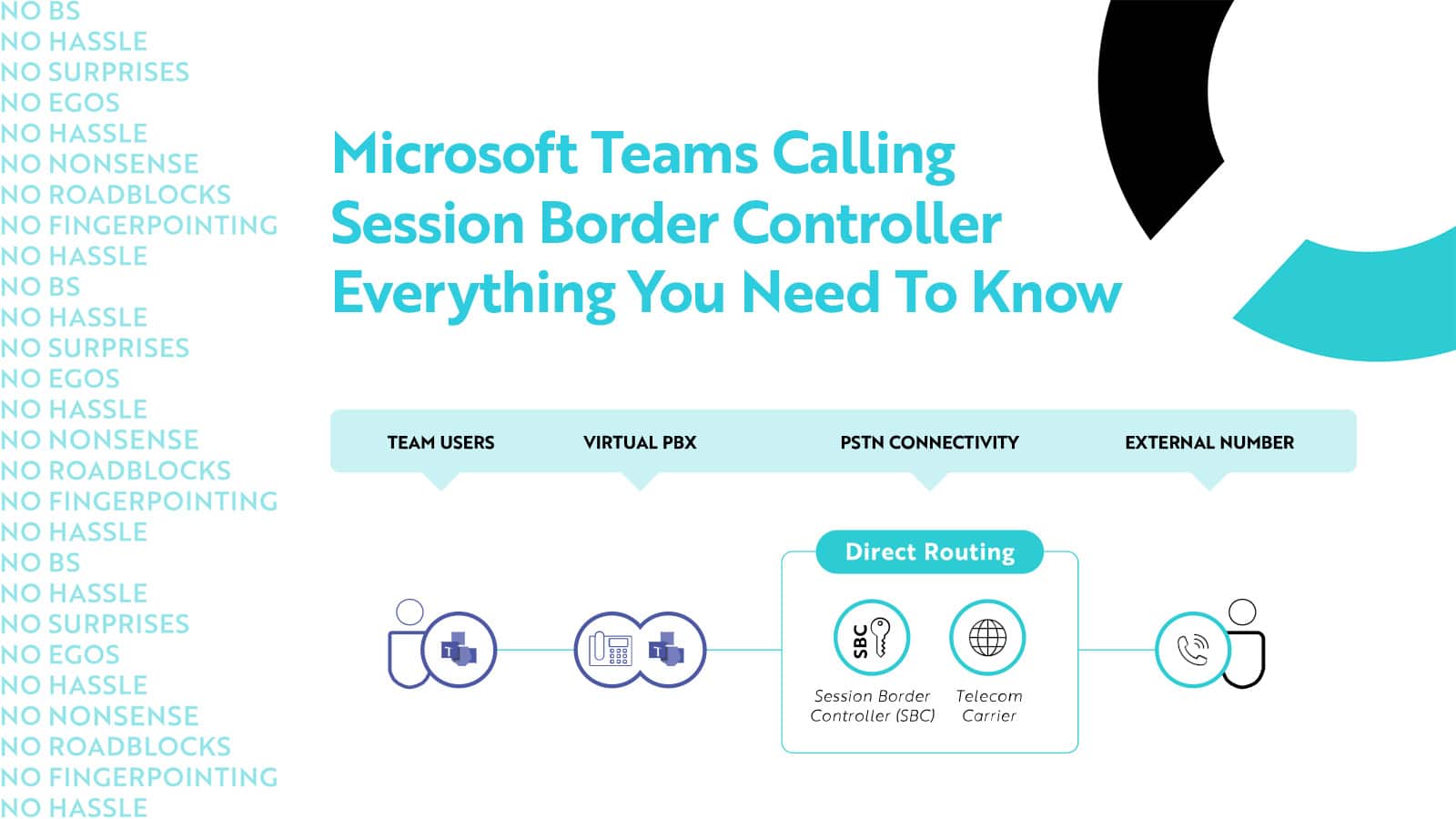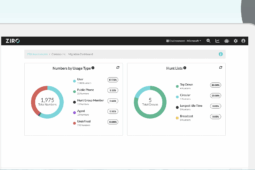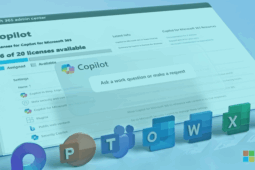
Microsoft Teams is one of the most popular and powerful platforms for collaboration and seamless remote teamwork in modern business communications. With its integrated calling capabilities, Microsoft Teams enables organizations to make and receive calls directly within the platform, transforming it into a comprehensive, unified communications solution. However, to fully leverage the potential of Teams calling and integrate it into other systems like the PSTN, on-premises PBX systems, or call centers, a Microsoft Teams SBC (Session Border Controller) is an important consideration.
As a leading authority in Microsoft Teams Calling, we aim to provide you with an in-depth understanding of session border controllers and how they enhance the performance and security of your communication infrastructure.
What is a Microsoft Teams SBC (Session Border Controller)?
A session border controller is a network device or software application that acts as the gatekeeper between two or more communication networks, ensuring the smooth and secure flow of data packets during voice, video, and other multimedia sessions. It serves as the interface between a private IP network (such as an enterprise network) and a public IP network (such as the Internet or a service provider network).
What are Microsoft Teams SBC essential functions?
A Microsoft Teams SBC serves as a critical component in ensuring seamless and secure communication within the Microsoft Teams environment. It performs a range of essential functions that enhance the overall performance, security, and interoperability of Microsoft Teams calling. Let’s explore the key functions of a Microsoft Teams SBC in more detail:
Session Control and Security
The SBC controls session initiation, termination, and management, allowing seamless communication between networks. By establishing strict security policies and employing various protocols, including Transport Layer Security (TLS) and IP Security (IPsec), an SBC ensures the confidentiality, integrity, and authenticity of data transmitted over the networks.
Network Interoperability
In today’s interconnected world, communication networks may utilize various protocols, codecs, and signaling methods. A Microsoft Teams SBC bridges these gaps, enabling interoperability between disparate networks. The SBC performs protocol translation, media transcoding, and call admission control, ensuring that different devices and networks can communicate effectively.
Quality of Service (QoS)
To guarantee high-quality communication experiences, SBCs play a critical role in managing and optimizing network resources. SBCs prioritize traffic, enforce bandwidth limitations, and mitigate network congestion, ensuring that real-time communications, such as voice and video, receive the necessary bandwidth and consistent quality of service.
Regulatory Compliance
Compliance with industry standards and regulations is paramount in today’s regulatory landscape. Microsoft Teams SBCs assist organizations in meeting these requirements by enforcing privacy, data protection, and lawful interception policies. They enable businesses to maintain regulatory compliance while benefiting from the advantages of modern communication technologies.
How to select the right Microsoft Teams SBC?
Choosing the appropriate Microsoft Teams SBC for your organization’s needs requires careful consideration of various factors. Here are some essential aspects to evaluate:
Scalability and Performance
Consider the anticipated volume of concurrent sessions and the desired performance levels. Ensure the SBC can handle the projected traffic while delivering optimal performance without compromising quality or security.
Security Features
Evaluate the security capabilities of the Microsoft Teams SBC, including encryption protocols, access controls, and threat detection mechanisms. Robust security features are vital to safeguard your communication infrastructure from potential vulnerabilities and attacks.
Interoperability
Verify that the SBC supports your network environment’s protocols, codecs, and signaling methods. Seamless interoperability between various systems is essential to guarantee efficient communication across networks.
Vendor Support and Reliability
Choose a Microsoft Teams SBC from a reputable vendor with a proven track record of providing reliable and responsive customer support. Vendor reliability is crucial in maintaining the uninterrupted performance of your communication infrastructure.
Cost-effectiveness
Consider the total cost of ownership, including upfront expenses, maintenance costs, and scalability options. Deployment, configuration and monitoring of the SBC may require competencies that your team does not have, requiring external assistance and/or training. Compare different solutions to determine the best balance between functionality, performance, and affordability.
What are the applications of a Microsoft Teams SBC?
A Microsoft Teams Session Border Controller (SBC) offers various applications and use cases that enhance the functionality, security, and interoperability of Microsoft Teams calling. Let’s explore the different applications of a Microsoft Teams SBC in more detail:
Connectivity with Legacy Phone Systems
One critical application of a session border controller is facilitating connectivity with legacy phone systems. Many organizations have existing on-premises PBX (Private Branch Exchange) systems or other traditional telephony infrastructure. By deploying an SBC, organizations can integrate their legacy systems with Microsoft Teams, enabling seamless communication between the new and existing platforms. This connectivity allows users to make and receive calls through Microsoft Teams while leveraging the existing telephony infrastructure.
Enabling Direct Routing
Direct Routing is a feature of Microsoft Teams that enables organizations to connect their telephony infrastructure or third-party telephony providers to Microsoft Teams. A Microsoft Teams SBC plays a critical role in this scenario by acting as the connection point between the external telephony network and Microsoft Teams. It provides the necessary mediation and interoperability functions to ensure smooth communication between Microsoft Teams and the external telephony infrastructure, enabling users to make and receive calls from within the Teams environment.
Supporting PSTN Connectivity
Public Switched Telephone Network (PSTN) connectivity is essential for organizations that make and receive calls to and from traditional phone numbers, mobile networks, or international destinations. A Microsoft Teams SBC can connect to PSTN gateways or SIP trunking providers, allowing organizations to route calls between Microsoft Teams and the PSTN. This routing enables users to communicate with external phone numbers seamlessly, ensuring the reachability and accessibility of Microsoft Teams as a comprehensive communication solution.
Enhancing Security and Compliance
Security and compliance are crucial considerations in any communication infrastructure. A Microsoft Teams SBC enhances security by acting as a firewall and access control point, protecting the Microsoft Teams environment from potential threats and unauthorized access. It ensures that communication sessions are encrypted and enforces security policies to comply with regulatory requirements and data protection standards. By incorporating an SBC into the Microsoft Teams calling setup, organizations can strengthen their security posture and ensure compliance with industry-specific regulations.
Supporting Contact Center Integration
Integrating Microsoft Teams with their contact center solutions is critical for many organizations. A Microsoft Teams SBC enables seamless integration by connecting Microsoft Teams calling capabilities with the contact center infrastructure. It facilitates call routing, recording, and other essential contact center functionalities, ensuring efficient and effective communication between contact center agents and customers through Microsoft Teams. This application enables organizations to leverage the collaborative power of Teams while enhancing their customer service operations.
What else should I consider when choosing a session border controller?
When choosing an SBC for Microsoft Teams, you should consider physical redundancy, geographic separation, location, latency, and emergency call handling for optimal communications. These considerations and careful planning and progressive deployment will ensure a successful migration to Microsoft Teams.
Physical Redundancy
Considering the importance of your UC communications, it’s critical to ensure that your SBC infrastructure is resilient from failures that would hamper your ability to make and receive PSTN calls. Deploying pairs of SBCs reduces a single point of failure from your environment and ensures that if an issue arises with an SBC, you have another device to pick up the traffic and continue delivering your PSTN service. It is important to note that due to SBC licensing constraints, you may be required to double up on licensing to ensure that each SBC has enough channels to handle all of your voice traffic. In a single-tenant environment, this can be cost-prohibitive.
Geographic Redundancy
You should ensure that your SBCs are installed in geographically separated data centers. If using a Virtual SBC, then using multiple Azure or AWS regions is highly recommended. You want to ensure that your SBCs are installed in geographies where a disaster in one will not impact the other, even if for SBCs installed within physical data centers.
Location and latency
You want to ensure that you test the latency between your SBC and your Microsoft media node to ensure it does not exceed 150 MS. I Optimal placement of SBCs to serve your users is critical to call quality and user experience. Appropriate dial plan and PSTN configurations must be implemented to ensure optimal call routing for a given user, both inbound and outbound. Hybrid Deployment for Progressive Migration
Successful migration to Microsoft Teams Calling involves careful planning and testing. In large organizations moving over all users at once presents significant risks. In order to support progressive migration, you will need to interface Teams, your SBC, and your existing on-premise systems. This will allow users to continue communicating as they migrate from one platform to another.
Emergency Call Handling
Ensuring appropriate configurations to handle 911 calls for on-premise and remote users is critical. This requires appropriate configuration both for the SBC and with your PSTN carriers.
What different types of Microsoft Teams SBCs are available?
Various types of Microsoft Teams Session Border Controllers (SBCs) are available, each offering unique features and capabilities. Let’s explore the different types of Microsoft Teams SBCs in more detail:
Hardware-Based SBCs
Hardware-based SBCs are physical appliances specifically designed to handle the routing, security, and interoperability requirements of Microsoft Teams calling. These devices are purpose-built and optimized for performance, providing high-capacity processing power and dedicated hardware components for efficient call handling. Hardware-based SBCs are often preferred for large-scale deployments or organizations with extensive calling needs, offering robust performance, scalability, and redundancy options.
Virtualized SBCs
Virtualized SBCs, also known as software-based SBCs or virtual SBCs, run on standard server hardware or virtual machines (VMs). They leverage virtualization technologies’ computing power and flexibility to deliver SBC functionality without needing dedicated hardware appliances. Virtualized SBCs offer scalability and cost-efficiency, as multiple instances can be deployed on a single server or distributed across a virtualized environment. They are suitable for organizations seeking flexibility, easy scalability, and the ability to run multiple virtual instances on existing infrastructure.
Cloud SBCs
Cloud SBCs are SBC solutions hosted and operated in the cloud. They provide the benefits of virtualized SBCs but with the added convenience of cloud deployment. Cloud SBCs eliminate the need for organizations to manage their hardware or infrastructure, as the SBC functionality is provided as a service. Cloud SBCs are particularly useful for organizations with distributed teams, remote workers, or those seeking a hassle-free and easily scalable solution. They offer simplified deployment, management, and automatic updates, allowing organizations to focus on their core operations.
Session Border Controller as a Service (SBCaaS)
Session Border Controller as a Service (SBCaaS) is a subscription-based model where a third-party provider provides the SBC functionality as a fully managed service. With SBCaaS, organizations can leverage the expertise and infrastructure of the service provider, eliminating the need for in-house SBC management and maintenance. SBCaaS offers scalability, flexibility, and simplified administration, making it an attractive option for organizations looking to offload the complexities of SBC deployment and management.
Conclusion
Session border controllers serve as indispensable components in modern communication networks. By ensuring secure, interoperable, and high-quality communication sessions, SBCs enhance the performance, reliability, and security of your organization’s voice and data transmissions. Understanding the essential functions and benefits of SBCs and carefully selecting the right solution for your needs can empower your business with a robust and future-ready communication infrastructure.
Remember, regarding session border controllers, we are your trusted partner in optimizing your communication infrastructure. Contact us today to explore how our expertise can propel your business forward.
Ready to take your unified communications from headache to hassle-free?
No throwing darts at proposals or contracts. No battling through the back-end. No nonsense, no run-around.



